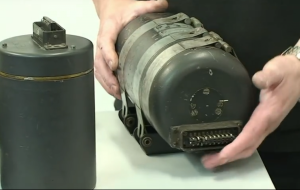
Watch our project to restore the relics of a V2 rocket’s Vertikant gyro guidance system, and its power supply components, back to full functionality after over seven decades of uncertain storage conditions.
The German A4-V2 rocket was the world’s first long range ballistic missile and space vehicle and it would become the type specimen for almost every subsequent liquid-fueled rocket made in the following decade. This video follows our project to restore parts of the V2’s guidance system, including an original ‘Vertikant’ gyro and its original DC to 3-phase AC power supply system. The parts we’ve acquired look very good on the outside with what appears to be just a few minor faults on the inside. Faults that will be easy enough to fix, like slightly bent ‘fly legs’ – as the German technicians called the thin fragile brass contacts that function to maintain electrical continuity with rotating parts. But we don’t know if there are more serious defects deeper inside where we can’t see them. We don’t know how they have survived and we know nothing of why they were originally abandoned. Perhaps they are all manufacturing or field rejects and won’t work any better now than when they were first rejected over 70 years ago?
Perhaps damp and decay have slowly ruined some or all of the parts? It would hardly be a surprise. After all, the German technicians who designed and built the equipment, had proved during the war that delays in use as short as two weeks were sufficient to reduce the performance of the most sophisticated missile equipment. And the gyroscopic guidance system is certainly one of the most sophisticated and fragile elements of any missile.
Our components are all over 70 years old and have endured uncertain storage conditions through the decades. Without a reliable wiring system, we may not be able to test them. And, in principle, the guidance equipment aboard the V2 missile was built for a combat service life that could be measured in minutes – can the equipment possibly work after all this time in storage?
Presented by V2 Rocket History’s Robert J Dalby FRAS
With special thanks to: Martin Bowman and Don Carr of Kearsley Airways Ltd, Romeera House Stansted Airport Essex, UK. Also our thanks to: Deutsches Museum Munich, Germany

